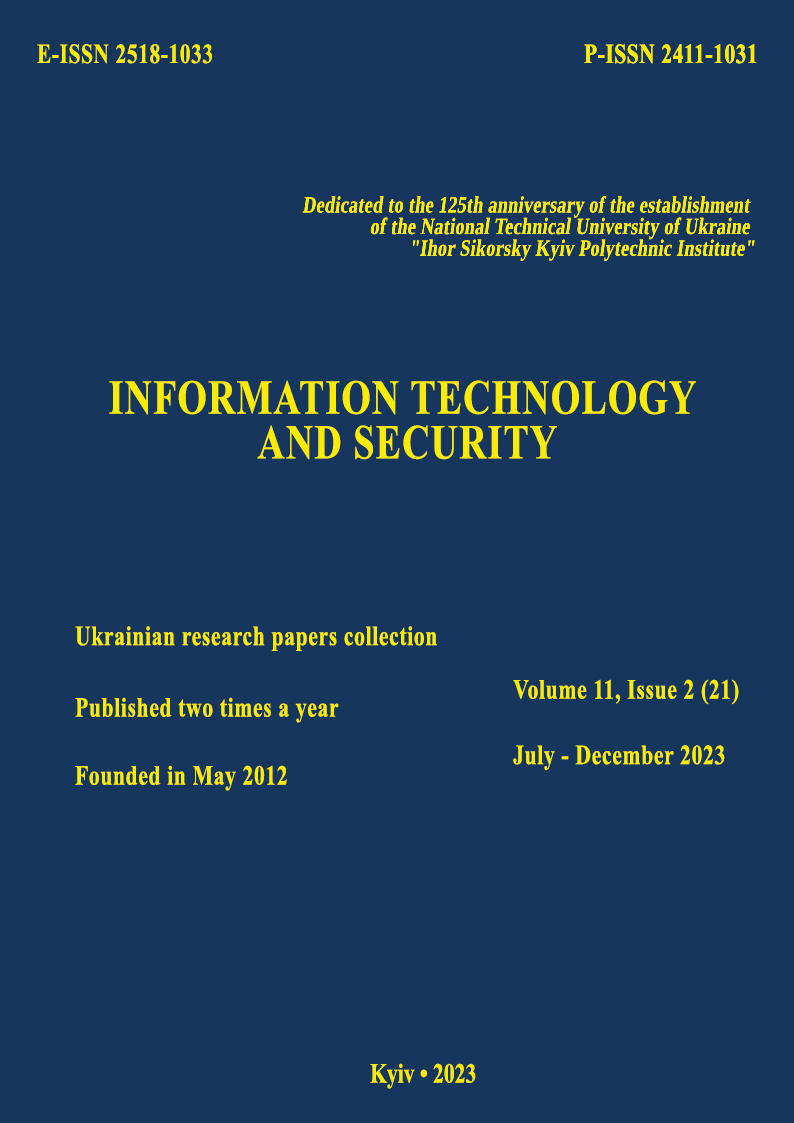Expanding the functionality of IoT devices in conditions of emergency situations
DOI:
https://doi.org/10.20535/2411-1031.2023.11.2.293493Keywords:
Internet of Things, IoT device programming, Python, smart LED lamp, public awareness during warAbstract
The article is devoted to the expansion of functional devices of the Internet of Things (IoT) in order to increase the safety of the population in emergency situations, in particular in the context of natural disasters and military threats. After analyzing the latest research and publications, a conclusion was made about the relevance of the development of IoT technologies in the context of modern challenges for the safety of citizens. Special emphasis is placed on the use of innovative approaches to solving public safety problems, particularly for persons with disabilities, such as the hearing impaired or the elderly. The article describes the implementation of software in the Python programming language to visually display the status of a missile threat or artillery fire using Yeelight smart lamps, which use colored light to convey information about the presence or absence of danger messages. The proposed solutions include synchronous operation of devices in real time, connection to reliable sources of messages and provision of stable communication between devices and the server. The project demonstrated an innovative approach to solving security problems in crisis situations, in particular martial law, promoting a quick and accurate response to valuable threats and protecting the population.
References
M. Trinath Basu, R. Karthik, J. Mahitha, and V. Lokesh Reddy, “IoT based forest fire detection system”, International Journal of Engineering and Technology (UAE), vol. 7, no. 2, pp. 124-126, 2018. [Online]. Available at: https://www.researchgate.net/publication/324054113_IoT_based_forest_fire_detection_system. Accessed on: Sep 10, 2023. doi: https://doi.org/10.14419/ijet.v7i2.7.10277.
K. Sharma, D. Anand, M. Sabharwal, P. Tiwari, O. Cheikhrouhou, and T. Frikha, “A Disaster Management Framework Using Internet of Things-Based Interconnected Devices”, Mathematical Problems in Engineering (Special Issue: Meta-Heuristic Techniques for Solving Computational Engineering Problems 2021), vol. 2021, pp. 1-21, 2021. [Online]. Available at: https://www.hindawi.com/journals/mpe/2021/9916440. Accessed on: Sep 19, 2023. doi: https://doi.org/10.1155/2021/9916440.
A. Sinha, P. Kumar, N. Rana, R. Islam, and Y. Dwivedi, “Impact of internet of things (IoT) in disaster management: a task-technology fit perspective”, Annals of Operations Research, 283 (1-2), pp.759-794, 2017. [Online]. Available at: https://doi.org/10.1007/s10479-017-2658-1. Accessed on: Oct. 03, 2023. doi: https://doi.org/10.1007/s10479-017-2658-1.
S. Moessner, R. Ramaswamy, and S. Tripathi, “Internet of Things (IoT): a literature review”, Journal of Computer and Communications, vol. 03, no. 05, pp. 164-173, 2015. [Online]. Available at: https://www.scirp.org/journal/PaperInformation?PaperID=56616abstract. Accessed on: Oct. 05, 2023. doi: https://doi.org/10.4236/jcc.2015.35021.
M. U. Farooq, and M. Waseem, “A Review on Internet of Things (IoT)”, International Journal of Computer Applications, vol. 113, pp. 1-7, 2015. [Online]. Available at: https://www.researchgate.net/publication/273693976_A_Review_on_Internet_of_Things_
IoT. Accessed on: Oct. 15, 2023. doi: https://doi.org/10.5120/19787-1571.
The official website of the Python programming language. [Online]. Available at: https://www.python.org. Accessed on: Oct. 12, 2023.
The official Python documentation of the YeeLight library. [Online]. Available at: https://yeelight.readthedocs.io/en/latest Accessed on: Oct. 12, 2023.
The official Python documentation of the pyTelegramBotAPI. [Online]. Available at: https://pypi.org/project/pyTelegramBotAPI. Accessed on: Oct. 15, 2023.
The official Python documentation for the Auto PY to EXE. [Online]. Available at: https://pypi.org/project/auto-py-to-exe. Accessed on: Oct. 15, 2023.
Downloads
Published
How to Cite
Issue
Section
License
Copyright (c) 2023 Collection "Information Technology and Security"

This work is licensed under a Creative Commons Attribution 4.0 International License.
The authors that are published in this collection, agree to the following terms:
- The authors reserve the right to authorship of their work and pass the collection right of first publication this work is licensed under the Creative Commons Attribution License, which allows others to freely distribute the published work with the obligatory reference to the authors of the original work and the first publication of the work in this collection.
- The authors have the right to conclude an agreement on exclusive distribution of the work in the form in which it was published this anthology (for example, to place the work in a digital repository institution or to publish in the structure of the monograph), provided that references to the first publication of the work in this collection.
- Policy of the journal allows and encourages the placement of authors on the Internet (for example, in storage facilities or on personal web sites) the manuscript of the work, prior to the submission of the manuscript to the editor, and during its editorial processing, as it contributes to productive scientific discussion and positive effect on the efficiency and dynamics of citations of published work (see The Effect of Open Access).

